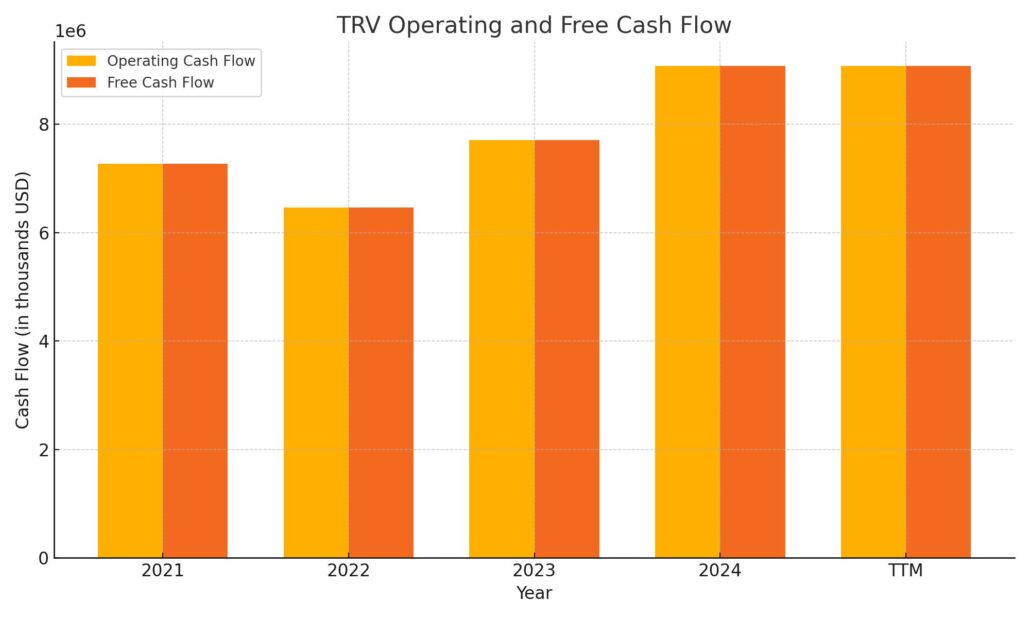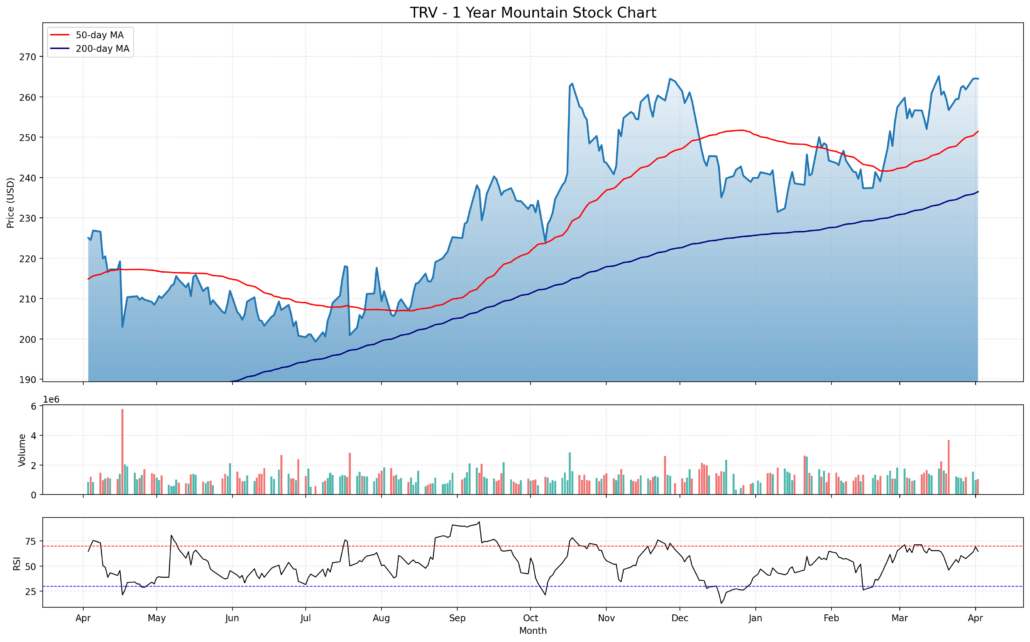Updated April 2025
There’s something to be said for consistency. In a market filled with high-flyers and headlines, Travelers Companies just keeps doing its job—quietly, reliably, and with a clear focus on delivering long-term value. For income-focused investors, especially those who appreciate a company that knows how to treat its shareholders, TRV deserves more than a passing glance.
Founded way back in 1853, Travelers has grown into one of the most well-established property and casualty insurers in the U.S. With operations in personal, business, and specialty insurance, it doesn’t rely too heavily on any one area. That balance, along with disciplined risk management, has helped the company remain steady through a lot of economic ups and downs.
Lately, it’s been doing more than just staying the course—it’s been accelerating. Earnings are strong, cash flow is impressive, and the dividend keeps climbing. For investors looking to build a reliable income stream, there’s plenty to like here.
🗓️ Recent Events
Travelers has been putting up some quietly impressive numbers lately. The stock has climbed roughly 15% over the past year, easily outpacing the broader market. This isn’t the result of hype or speculation—just strong, steady performance from a company that knows its strengths.
The most recent quarter showed a 28% jump in earnings compared to the previous year. That’s not a small move for an insurer. Revenue also rose nearly 10%, signaling strong demand across the board. A combination of solid underwriting, smart pricing, and lower-than-expected catastrophe losses all played into those results.
Right now, the stock is trading just under $265, close to its 52-week high. The valuation is reasonable too, with a trailing P/E just above 12 and a forward P/E near 14. For a company with a nearly 19% return on equity and a consistent track record of profitability, that’s not a stretch.
Then there’s the balance sheet. Operating cash flow has crossed $9 billion over the trailing twelve months, and free cash flow is even more impressive at $16.5 billion. Debt remains modest, with a debt-to-equity ratio around 30%. The company also holds over $5 billion in cash. All this gives Travelers a lot of flexibility—not just to weather storms, but to keep rewarding its shareholders.
📊 Key Dividend Metrics
💵 Forward Dividend Rate: $4.20 per share
📈 Forward Yield: 1.59%
🧮 5-Year Average Yield: 2.17%
🧱 Payout Ratio: 19.3%
📆 Next Dividend Date: March 31, 2025
🔁 Last Dividend Increase: Annual tradition continues
💪 Dividend Safety: Exceptionally strong
📥 Dividend Overview
Travelers doesn’t chase high yields. Instead, it offers something that’s arguably more valuable for long-term investors: dependability. At a current forward yield of 1.59%, it’s not going to top anyone’s income list, but that number only tells part of the story.
The real appeal lies in how secure the dividend is. A payout ratio of just under 20% means the company is only using a small fraction of its earnings to fund the dividend. That leaves plenty of room for increases, even if profits were to take a temporary hit. It’s the kind of financial cushion income investors can appreciate.
Another key piece is how this fits into the broader shareholder return picture. Travelers continues to buy back shares at a solid clip, which helps support the stock price and boosts per-share results over time. Fewer shares mean every dollar of earnings and every cent of dividend goes a little bit further.
The yield is a little lower than its five-year average of 2.17%, but that’s mostly due to the stock’s recent rally. Investors are clearly confident in the company’s trajectory—and they’re willing to accept a lower yield because they see the long-term value.
📈 Dividend Growth and Safety
This is where Travelers really shines. For nearly two decades, the company has been increasing its dividend every year. The hikes are typically modest—think 5% to 7%—but steady. That kind of predictability is gold for anyone building a long-term income strategy.
What makes those increases even more impressive is how well they’re supported by the company’s fundamentals. With billions in free cash flow, a conservative payout ratio, and a rock-solid balance sheet, Travelers has plenty of room to keep those raises coming.
In fact, they don’t even have to think twice about it. Even in tough years, the company has managed to maintain its dividend policy without blinking. The insurance business may be cyclical, but TRV’s approach is anything but reactive.
Just look at some of the supporting numbers:
- Operating cash flow: $9 billion
- Free cash flow: $16.5 billion
- Total debt: $8.3 billion
- Cash on hand: $5.5 billion
This kind of financial profile means the dividend isn’t just sustainable—it’s insulated. It’s rare to find that kind of consistency in the market, especially paired with a history of disciplined capital allocation.
The company’s beta of 0.62 also reflects its low-volatility nature. That’s a plus for income investors who prioritize stability over flash. You’re not going to see wild price swings here—but you are likely to see regular deposits into your brokerage account.
In a market full of noise, Travelers has managed to stay focused on its core strengths: conservative underwriting, efficient operations, and generous—but responsible—shareholder returns. For dividend investors, that’s a combination that’s hard to beat.
Cash Flow Statement
Travelers continues to generate strong and steady operating cash flow, reaching $9.07 billion over the trailing twelve months. That’s a notable increase from $7.71 billion in the prior year and reflects the company’s ability to convert underwriting profits into real cash. This strength is important for funding dividend payouts and share repurchases without tapping external sources. Free cash flow matched operating cash flow dollar-for-dollar, indicating minimal capital expenditure drag on liquidity.

On the investing side, Travelers reported outflows of $7.26 billion, largely aligned with prior years, as the company continued deploying capital across its investment portfolio. Financing activities reflected a net outflow of $1.75 billion, which included $1.12 billion in share repurchases—a clear sign of commitment to shareholder returns. The company ended the period with $699 million in cash, slightly higher than the previous year. While this balance isn’t massive, it’s consistent and reflects efficient capital use. Tax payments rose significantly to $1.31 billion, a byproduct of rising earnings, while interest expenses remained modest. Overall, cash flow trends at TRV suggest a well-managed capital structure with more than enough flexibility to sustain and grow dividends.
Analyst Ratings
📉 In December 2024, Wells Fargo downgraded TRV from “Equal Weight” to “Underweight,” trimming its price target from $256 to $217. The move was driven by concerns about potential general liability reserve additions and tougher margin comparisons expected in 2025. Analysts flagged persistent pressure from rising loss cost trends in the commercial lines segment, suggesting this could weigh on profitability in the coming quarters.
📈 In contrast, February 2025 saw Keefe, Bruyette & Woods (KBW) take a more optimistic stance, upgrading TRV from “Market Perform” to “Outperform.” Their upgrade was based on the belief that Travelers may have been overly conservative in prior reserve estimates, which could result in reserve releases and provide a tailwind for future earnings. That shift in tone reflected a growing confidence in TRV’s underlying risk management and earnings quality.
🔁 Then in March 2025, HSBC took a more neutral approach by moving from a “Buy” to a “Hold” rating, setting a price target at $270. While not a negative outlook, it did reflect a more cautious stance on the stock’s short-term upside, with expectations of a plateau in earnings momentum.
🎯 As it stands, the current analyst consensus points to an average price target of $276.80. With TRV trading just below that mark, the market appears to be valuing the company fairly close to where the broader analyst community sees it heading.
Chart Analysis

Price Action and Moving Averages
The chart reveals a steady uptrend that gained traction beginning in the second half of the year. After a stretch of sideways movement between April and mid-July, the stock broke out and climbed decisively. That upward momentum really started to firm up once the price crossed back above the 50-day moving average in late August. Since then, the 50-day has acted as a consistent support level, staying above the 200-day for most of the back half of the year.
The 200-day moving average continues to slope upward, which reflects a strong longer-term trend. Even during pullbacks—like the one seen in late October and again briefly in early March—the stock respected this broader trendline, bouncing higher each time. This type of technical behavior points to steady institutional demand on dips.
Volume and Participation
Volume has remained relatively stable throughout the year, with a few spikes that lined up with stronger rallies and selloffs. Notably, there was increased buying volume during the late October breakout and again in mid-February. This kind of volume support on advances suggests genuine interest behind the price moves, not just passive drift.
One encouraging sign is that volume didn’t dry up even during consolidations, which points to continued accumulation rather than distribution. While there were a few red volume bars, the price didn’t break support levels significantly, which reinforces the strength of the underlying trend.
RSI and Momentum
The RSI line has mostly hovered in the neutral-to-bullish range since late summer. There was a clear move into overbought territory in September, followed by a healthy cooldown. More recently, RSI has edged close to 70 again but hasn’t broken through in a dramatic way. This kind of steady approach toward overbought levels—without sharp reversals—suggests momentum is strong but not overextended.
Interestingly, during the early-year pullback in January, RSI stayed above 30, which shows buyers stepped in quickly. These kinds of shallow corrections are typically seen in trending, well-supported stocks.
Overall, the chart reflects controlled strength, strong trend alignment, and disciplined buying. This setup supports a thesis of ongoing confidence and demand around current levels, especially after the higher lows and reclaiming of recent highs through March.
Earning Report Summary
Strong Bottom-Line Growth
Travelers wrapped up the fourth quarter of 2024 with some really solid numbers. Net income came in at just over $2 billion, which breaks down to $8.96 per diluted share. That’s a meaningful jump from where they were a year ago. Core income also moved higher, hitting $2.13 billion, or $9.15 per share. When you look at those figures side by side with last year’s, it’s clear the company had a very strong finish to the year.
Underwriting Remains a Core Strength
What stood out most in this report was how well Travelers managed its underwriting. The combined ratio dropped to 83.2%, showing the company wrote profitable business and kept claims well under control. The underlying combined ratio improved to 84%, which shows their day-to-day risk management is still razor sharp. In the insurance world, keeping those ratios in check is key, and Travelers continues to do that better than most.
Premiums Keep Climbing
Premium growth was another bright spot. Net written premiums reached $10.74 billion, a 7% gain from the same quarter last year. All three major business segments contributed to that growth, which signals strong demand across the board. The company’s ability to grow premiums consistently—while staying disciplined on underwriting—points to a healthy and balanced approach.
Investment Income Picks Up
On the investment side, income jumped by 23% compared to the prior year’s quarter. With interest rates higher and a stable investment strategy in place, that kind of growth added a nice tailwind. It’s a reminder that even beyond insurance operations, Travelers knows how to manage capital efficiently and put its cash to work.
Solid Financial Position
Book value per share increased to $122.97, and adjusted book value came in at $139.04, both up 13% from the end of 2023. That kind of growth in book value speaks to strong capital discipline and a business that’s compounding value effectively over time.
Even with headwinds like catastrophe losses from events such as the wildfires in California, Travelers showed it can handle volatility without missing a beat. The company’s performance this quarter reflects a steady hand at the wheel and a clear focus on long-term results, not just short-term wins.
Management Team
At the helm of Travelers Companies is Alan D. Schnitzer, who has been serving as Chairman and Chief Executive Officer since December 2015. With nearly two decades at Travelers, Schnitzer has held various key leadership roles, bringing a wealth of experience and a deep understanding of the company’s operations. His tenure is marked by a focus on innovation and strategic growth, positioning Travelers as a leader in the insurance industry.
Supporting Schnitzer is Daniel S. Frey, the Chief Financial Officer and Executive Vice President since September 2018. Frey’s extensive background in financial management within the insurance sector, including previous roles as Senior Vice President and Chief Financial Officer for the Personal Insurance segment, equips him with the expertise to oversee the company’s financial strategies effectively.
The leadership team is further strengthened by Mojgan M. Lefebvre, who serves as Executive Vice President and Chief Technology & Operations Officer. Lefebvre’s role is pivotal in driving technological advancements and operational efficiencies, ensuring that Travelers remains at the forefront of industry innovation.
Valuation and Stock Performance
As of April 2, 2025, Travelers’ stock (NYSE: TRV) is trading at $264.49. The company’s price-to-earnings (P/E) ratio stands at 12.32, which is relatively modest compared to industry peers, suggesting that the stock may be undervalued. The price-to-book (P/B) ratio is 2.15, indicating that the market values the company at just over twice its book value.
In terms of stock performance, Travelers has demonstrated resilience and growth. The stock reached an all-time high of $269.55 on October 18, 2024, and is currently trading approximately 4.8 percent below that peak. Over the past three months, TRV stock has gained 3.6 percent, outperforming the broader property and casualty insurance sector, which experienced a slight decline during the same period.
The company’s consistent performance is further evidenced by its 30 percent stock gain since the start of 2024, surpassing the S&P 500’s 25 percent increase over the same stretch. That kind of steady appreciation speaks to investor confidence and the company’s ability to deliver results through different market conditions.
Risks and Considerations
While Travelers has exhibited strong financial performance, it is not without risks. The company faces exposure to catastrophe losses, as evidenced by the significant impact of the Los Angeles wildfires, which resulted in a $1.7 billion loss. These events highlight the inherent volatility in the property and casualty insurance space and the potential for large-scale claims that can impact earnings.
Additionally, the evolving landscape of cyber threats presents a growing concern. Recognizing this, Travelers has launched enhanced services for cyber liability customers, aiming to help policyholders predict, prevent, and recover from cyber incidents. While this initiative demonstrates proactive risk management, the rapidly changing nature of cyber risks requires continuous vigilance and investment.
Economic factors, such as fluctuations in interest rates and investment income, also play a crucial role in the company’s financial health. As an insurer, Travelers depends on investment income to supplement underwriting profits, and any downturn in market yields or broader financial instability could pose a headwind to earnings.
Final Thoughts
Travelers Companies stands out as a robust entity in the insurance industry, backed by a seasoned management team and a track record of solid financial performance. The company’s strategic initiatives, including advancements in technology and cyber risk services, position it well to navigate the evolving challenges of the modern insurance environment.
That said, potential investors should remain mindful of the inherent risks that come with exposure to natural catastrophes and the unpredictability of emerging threats like cyberattacks. These are realities of the business, and they require an ongoing commitment to innovation, reserves management, and capital discipline.
In summary, Travelers represents a balance of financial strength, operational reliability, and strategic foresight. It has consistently shown that it can adapt, invest wisely, and deliver value, even in a competitive and often volatile industry.

